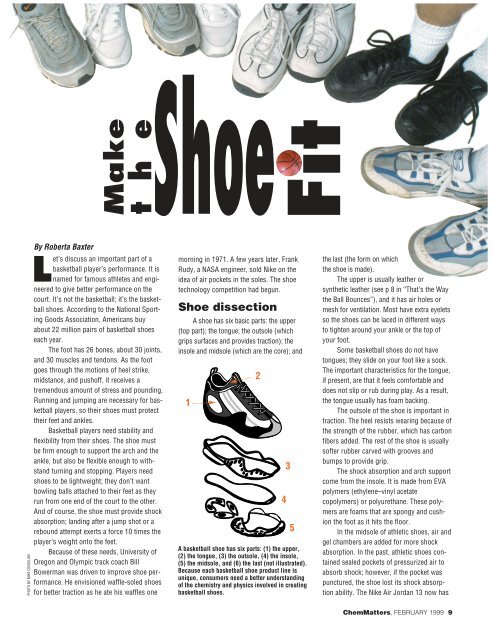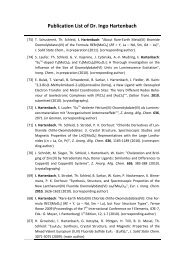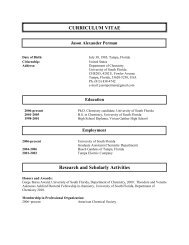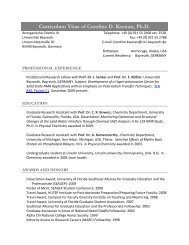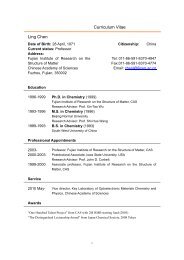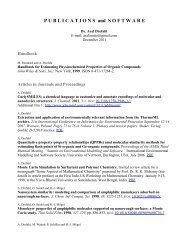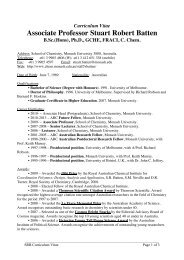Sports Drinks: Don't Sweat the Small Stuff - American Chemical ...
Sports Drinks: Don't Sweat the Small Stuff - American Chemical ...
Sports Drinks: Don't Sweat the Small Stuff - American Chemical ...
You also want an ePaper? Increase the reach of your titles
YUMPU automatically turns print PDFs into web optimized ePapers that Google loves.
PHOTO BY MIKE CIESIELSKI<br />
By Roberta Baxter<br />
Make<br />
Let’s discuss an important part of a<br />
basketball player’s performance. It is<br />
named for famous athletes and engineered<br />
to give better performance on <strong>the</strong><br />
court. It’s not <strong>the</strong> basketball; it’s <strong>the</strong> basketball<br />
shoes. According to <strong>the</strong> National Sporting<br />
Goods Association, <strong>American</strong>s buy<br />
about 22 million pairs of basketball shoes<br />
each year.<br />
The foot has 26 bones, about 30 joints,<br />
and 30 muscles and tendons. As <strong>the</strong> foot<br />
goes through <strong>the</strong> motions of heel strike,<br />
midstance, and pushoff, it receives a<br />
tremendous amount of stress and pounding.<br />
Running and jumping are necessary for basketball<br />
players, so <strong>the</strong>ir shoes must protect<br />
<strong>the</strong>ir feet and ankles.<br />
Basketball players need stability and<br />
flexibility from <strong>the</strong>ir shoes. The shoe must<br />
be firm enough to support <strong>the</strong> arch and <strong>the</strong><br />
ankle, but also be flexible enough to withstand<br />
turning and stopping. Players need<br />
shoes to be lightweight; <strong>the</strong>y don’t want<br />
bowling balls attached to <strong>the</strong>ir feet as <strong>the</strong>y<br />
run from one end of <strong>the</strong> court to <strong>the</strong> o<strong>the</strong>r.<br />
And of course, <strong>the</strong> shoe must provide shock<br />
absorption; landing after a jump shot or a<br />
rebound attempt exerts a force 10 times <strong>the</strong><br />
player’s weight onto <strong>the</strong> feet.<br />
Because of <strong>the</strong>se needs, University of<br />
Oregon and Olympic track coach Bill<br />
Bowerman was driven to improve shoe performance.<br />
He envisioned waffle-soled shoes<br />
for better traction as he ate his waffles one<br />
t h e<br />
Shoe<br />
morning in 1971. A few years later, Frank<br />
Rudy, a NASA engineer, sold Nike on <strong>the</strong><br />
idea of air pockets in <strong>the</strong> soles. The shoe<br />
technology competition had begun.<br />
Shoe dissection<br />
A shoe has six basic parts: <strong>the</strong> upper<br />
(top part); <strong>the</strong> tongue; <strong>the</strong> outsole (which<br />
grips surfaces and provides traction); <strong>the</strong><br />
insole and midsole (which are <strong>the</strong> core); and<br />
1<br />
A basketball shoe has six parts: (1) <strong>the</strong> upper,<br />
(2) <strong>the</strong> tongue, (3) <strong>the</strong> outsole, (4) <strong>the</strong> insole,<br />
(5) <strong>the</strong> midsole, and (6) <strong>the</strong> last (not illustrated).<br />
Because each basketball shoe product line is<br />
unique, consumers need a better understanding<br />
of <strong>the</strong> chemistry and physics involved in creating<br />
basketball shoes.<br />
2<br />
Fit<br />
4<br />
3<br />
5<br />
<strong>the</strong> last (<strong>the</strong> form on which<br />
<strong>the</strong> shoe is made).<br />
The upper is usually lea<strong>the</strong>r or<br />
syn<strong>the</strong>tic lea<strong>the</strong>r (see p 8 in “That’s <strong>the</strong> Way<br />
<strong>the</strong> Ball Bounces”), and it has air holes or<br />
mesh for ventilation. Most have extra eyelets<br />
so <strong>the</strong> shoes can be laced in different ways<br />
to tighten around your ankle or <strong>the</strong> top of<br />
your foot.<br />
Some basketball shoes do not have<br />
tongues; <strong>the</strong>y slide on your foot like a sock.<br />
The important characteristics for <strong>the</strong> tongue,<br />
if present, are that it feels comfortable and<br />
does not slip or rub during play. As a result,<br />
<strong>the</strong> tongue usually has foam backing.<br />
The outsole of <strong>the</strong> shoe is important in<br />
traction. The heel resists wearing because of<br />
<strong>the</strong> strength of <strong>the</strong> rubber, which has carbon<br />
fibers added. The rest of <strong>the</strong> shoe is usually<br />
softer rubber carved with grooves and<br />
bumps to provide grip.<br />
The shock absorption and arch support<br />
come from <strong>the</strong> insole. It is made from EVA<br />
polymers (ethylene–vinyl acetate<br />
copolymers) or polyurethane. These polymers<br />
are foams that are spongy and cushion<br />
<strong>the</strong> foot as it hits <strong>the</strong> floor.<br />
In <strong>the</strong> midsole of athletic shoes, air and<br />
gel chambers are added for more shock<br />
absorption. In <strong>the</strong> past, athletic shoes contained<br />
sealed pockets of pressurized air to<br />
absorb shock; however, if <strong>the</strong> pocket was<br />
punctured, <strong>the</strong> shoe lost its shock absorption<br />
ability. The Nike Air Jordan 13 now has<br />
ChemMatters, FEBRUARY 1999 9


